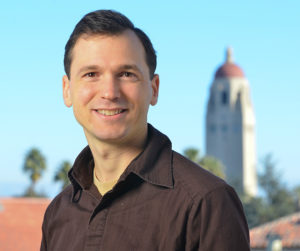
Stanford researchers have developed a new tool called Talkabout to enhance online learning through the formation of virtual discussion sections — allowing students from around the globe to connect and share ideas.
Talkabout is built around Google Hangouts and joins groups of 2 to 9 people in conversation. This feature will facilitate small-group discussion in order to improve massive open online courses (MOOCs), which are offered by Stanford and many other institutions and attract thousands of students from around the world.
Talkabout was developed by a group of Stanford researchers including Professor of Computer Science Michael Bernstein, Computer Science Ph.D. student Chinmay Kulkarni, and Scott Klemmer, a former Stanford Professor who currently works at UC San Diego.
According to Kulkarni, the project actually started with the work of a former undergraduate intern, Julia Cambre B.S. ’14 who now works for the MOOC platform Coursera.
The team first incorporated the system as part of a MOOC course on the subject of human-computer interaction, designed by Klemmer, who is now an Associate Professor of Cognitive Science and Computer Science & Engineering at UC San Diego.
Bernstein explained that the group encountered some difficulties during the course’s initial run.
During this first trial, the team offered a continually running Google Hangout session that served as open “office hours,” where students could talk with peers at any time. Because this setup struggled to attract enough students at any given time who could engage in conversation, the group revamped its approach to be oriented towards scheduled discussion sections.
“We started shifting toward a model that was more like bus stops, if you will, where there are certain times you can show up, and everyone shows up for them,” Bernstein said.
The new system works by randomly assigning a few people to each group. There is no moderator and students encounter new peers in each discussion section.
According to Kulkarni one of the great benefits of this technology is the different perspectives that people gain from interaction with others from around the world.
“[If you] participate in one of these rigorous discussions then you can see how a librarian in the Midwest and how someone who works at [the] United Nations both end up in the same class,” said Kulkarni.
Bernstein explained that there are two communication options to help incorporate people of varying levels of English language ability. Those with more confident English skills are more likely to speak, whereas those with more tentative skills are more likely to post text as part of the discussion.
Bernstein believes that an emphasis on good topics can bring people with different viewpoints together and draw upon the diversity of the participants to create an engaging educational experience.
“What we try to do with Talkabout is to create prompts that get people to relate course topics to their own local contexts in front of each other. And when you do that, you start to realize all these different ways that people see the world, or the different ways that they live their lives,” Bernstein said.
According to a recent paper referenced in the Stanford Report, Talkabout was both academically and socially effective. Students who participated in the sections improved by about half a letter grade, and, indeed, the sections with the most diverse students saw the most improvement.
In addition, athough students were only required to participate for 30 minutes, the median section length ended up being almost an hour.
Going forward, Kulkarni envisions several ways in which the technology might progress. Kulkarni hopes that sections will become more dynamic in the future; for example, beginning with a one-on-one conversation before moving to a six-person group. Kulkarni also hopes to combine online and in-person interactions, so as to benefit both students in physical Stanford classes as well as those enrolled in online courses.
Contact Skylar Cohen at skylarc ‘at’ stanford.edu.